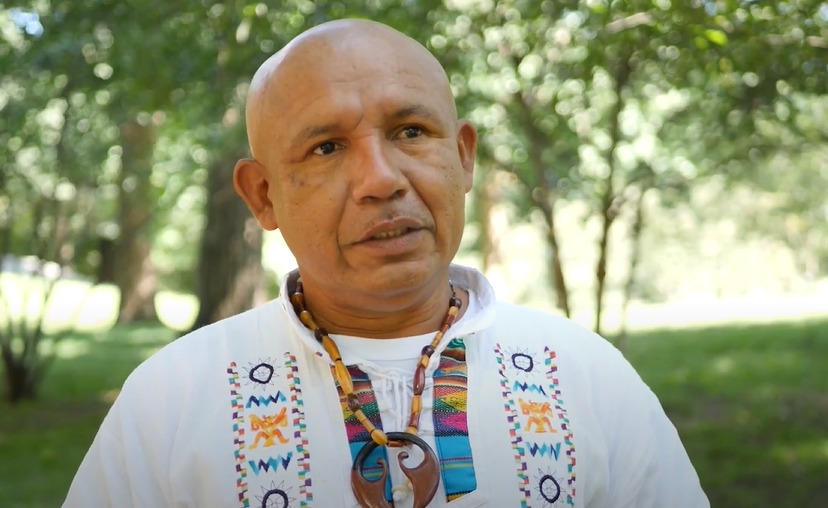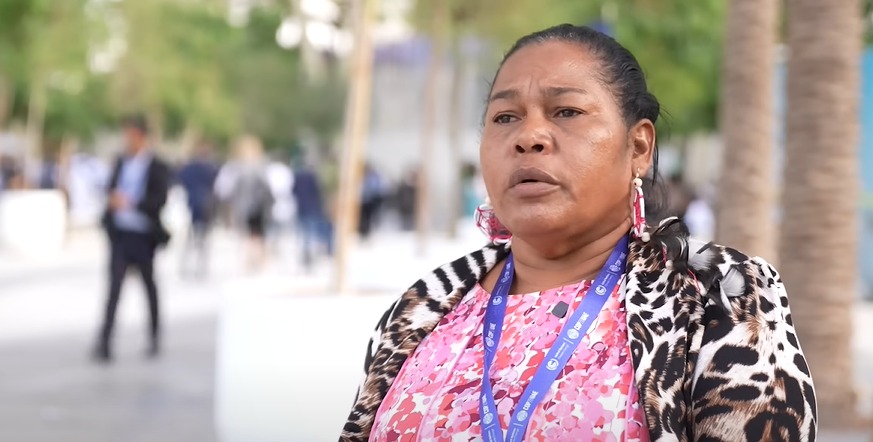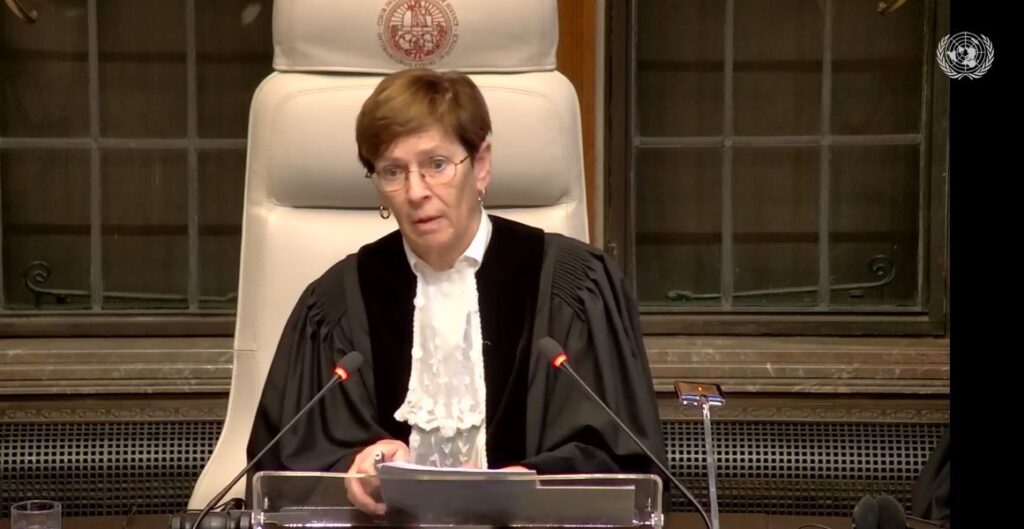Guyana’s Indigenous peoples reject Venezuela’s land grab plans
By Vishani Ragobeer in Dubai
Venezuelan President Nicolás Maduro wants to expand mining in the forest-rich Essequibo area of Guyana that his country claims and has now incorporated into its official map but Guyana’s Indigenous peoples have rejected these moves.
For various Indigenous groups in Guyana, the forests they depend on for sustenance and their livelihoods are directly threatened.
“When we look at the Essequibo region, where is home to almost 90% of the indigenous population, it is a threat to ownership of our land and it is total disregard for rights of Indigenous peoples,” Derrick John, the Chairman of the National Toshaos Council (NTC), said in Dubai where he is attending this year’s COP28 climate conference.
John is the Toshao or Chief of his community, Moraikobai. As the chairperson of a body made up of Indigenous leaders all across Guyana, he is akin to a Chief of Chiefs.

And according to him, Venezuela’s claim to Guyana’s land and actions being taken by the Maduro-led government concern all Indigenous peoples since they have a harmonic relationship with the natural environment. John believes the move threatens their occupancy of ancestral and titled lands.
“It’s a total disregard for our rights as Indigenous peoples but more so it is a threat to our natural resources found in this land.
“If- and I am using the word if- Venezuela should have its way, then we will lose everything we have achieved, we have fought for and we have protected for centuries and that will be really detrimental to us as Indigenous peoples,” John lamented.
Indigenous leadership, the World Wildlife Fund (WWF) in its “Living Planet Report 2022” said, is key to taking care of the earth. Indigenous lands, the report noted, have been better taken care of compared to other places where the “human activities driving climate change and habitat loss” have not been controlled.
What John fears is exactly that: Venezuela’s moves may force Indigenous peoples off of their land and/or change the way the land and its resources are used.
The Essequibo region claimed by Venezuela’s Maduro accounts for about two-thirds of Guyana’s entire landmass. It is an area that also includes a majority of Guyana’s more than 18 million hectares of forests.

Guyanese leaders, namely its President Dr. Irfaan Ali and Vice President Dr. Bharrat Jagdeo, have been at COP28 and other international fora boasting about these forests and the climate services they provide.
They are also seeking support for Guyana’s carbon credits venture which promises to earn Guyana billions of dollars from its intact forests. The funds will be used for climate adaptation (85% of all proceeds) and to support projects in Indigenous communities (15% of all proceeds).
At COP28, President Ali said Venezuela’s claims have no bearings on Guyana’s plans for its forests or other natural resources.
“First of all, we are very clear on where our borders are. We are pushing the forests because it is (sic) Guyana forests so we are not really factoring in the controversy in these climate talks,” he said during an exclusive interview with the News Room in Dubai.
But what is Venezuela planning?
President Maduro, during a December 5 press conference, released a redrawn map of Venezuela that includes Guyana’s Essequibo region. That region has been deemed ‘Guayana Esequiba.’
He also ordered the “immediate creation” of new divisions for the country’s oil and mining companies and said he will “grant licences for oil, gas and mines exploration.”
Guyana’s oil and gas resources are found offshore in the Exclusive Economic Zone (EEZ) linked to the Essequibo region. Mining is done in the forested region though it is largely prohibited on Amerindian lands and in protected areas.
But it is not yet clear how the Maduro government will pursue these ventures in territory that has been under Guyanese management. He also promised to build 120 “new, decent homes” in the Essequibo region and wants new centres of biodiversity and tourism there.

In Dubai, Venezuelan officials from the Ministry of Popular Power for Ecosocialism are keen on talking about Venezuela’s environmental plans. Side events there ranged from conversations on benefits of the bamboo to talks about human mobility and the climate crisis in Latin America and the Caribbean.
At their pavilion, Zone B3 Building 31, pictures and information of their forests and biodiversity plaster the walls. A huge map of Venezuela, that includes Guyana’s Essequibo region, is there too.
Carlos Manuel González Figueredo, an analyst with the Ministry of Popular Power for Ecosocialism, explained that the ministry is virtually the same as an “Environment Ministry.”
When asked about Venezuela’s environmental plans for the Guayana Esequiba, he went mum. He asked for any questions to be sent to his WhatsApp number, which he provided but has not been responsive to. He also shared a brochure from the pavilion and said all information on Venezuela’s environmental plans can be found in that brochure or on the Ministry’s website, http://www.minec.gob.ve/
Thay brochure has the map of Venezuela that includes Guyana’s Essequibo region. The website’s homepage features articles on President Maduro’s declarations on the Essequibo region.
Livelihoods at risk?
Toshao of Rivers’ View Melena Pollard, who is also in Dubai for COP28, said many of the residents in her community are concerned about any Venezuelan authorities seizing control of their land because it will disrupt their livelihoods.
“In the Essequibo region, that is where we have been getting jobs from. Men go to mine for gold and diamonds, we have shops there, our people use the river to do fishing and get their livelihood,” she explained.

Rivers’ View is a community found at the confluence of the Cuyuni, Mazaruni and Essequibo Rivers in Guyana. Small-scale mining has been part of their economic activity for years but the community has limited this, opting instead to greenlight the creation of a new rainforest research centre instead of new mining concessions.
Beyond the usual economic activities, Toshao Pollard that Venezuela’s actions can harm the forests Indigenous peoples rely on for food, medicine and their livelihoods. She also believes those actions can place Guyana’s carbon credits venture in limbo. In Rivers’ View, carbon credits funds secured from the major deal with the Hess Corporation in December 2022 have been used to revamp a wharf, establish a chicken feed project and build a benab and restaurant for tourists.
“If Venezuela is to come over, that is going to put our lives into jeopardy, our livelihood into jeopardy,” the Toshao said.
What’s the controversy?
The border controversy between Guyana and Essequibo is decades-old. The boundary, as internationally-recognised, was settled in 1899 through an Arbitral Award. It was accepted by Venezuela and Guyana (then British Guiana) until the 1960s as Guyana approached its independence.
A political mechanism known as the 1966 Geneva Agreement was set up to resolve the controversy but after decades of talks failed, the United Nations Secretary General referred the matter to the International Court of Justice (ICJ), which is the UN’s principal judicial organ. The court has determined it can hear and decide on the case, but Venezuela put forward a December 3 referendum before the Court can rule.
Two days before the referendum, the Court ruled that Essequibo has been recognised as Guyanese territory and has been governed by Guyana since the 1899 award so Venezuela should refrain from interrupting Guyanese sovereignty of the territory at least until the Court itself rules on the substantive border case.

Guyana’s Amerindian People’s Association (APA), a group that champions the rights of Indigenous Peoples, rejects Venezuela’s advances, contending that Venezuela has not traditionally occupied the land it now claims.
In a statement issued on December 7, the APA explained that Guyana’s Indigenous peoples have occupied the land since “time immemorial” and they “hold that territory sacred.” Additionally, the South Rupununi District Council (SRDC), in a December 2 statement, said the Essequibo region- called Chiipi Wa’o in Wapichan- has been traditionally occupied by Wapichan people “since before the colonisers came to the continent.”
So the APA and the SRDC back the government’s intention to defend the Essequibo region. The APA, in its statement, said: “we stand in solidarity with the Government of Guyana as it continues to advocate, per international law, for its sovereign territory to be respected. Additionally, the APA also supports the Guyanese Government’s right to defend its territory and people.”
(This story was published with the support of Climate Tracker through the COP28 Climate Justice Reporting Fellowship.)





